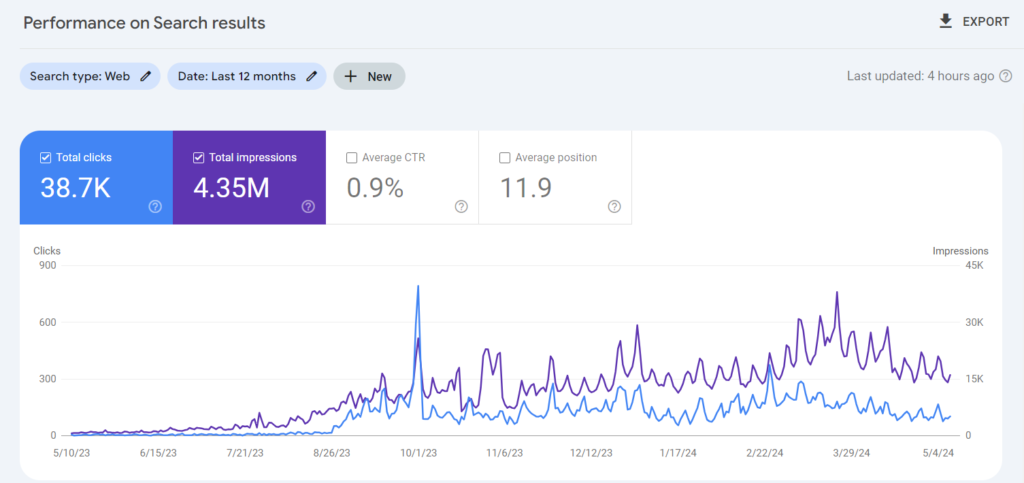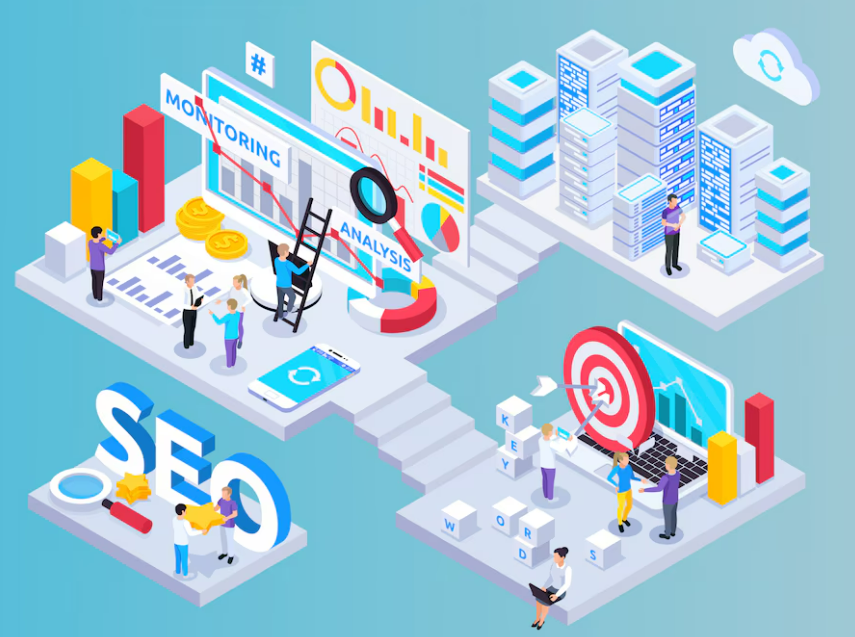If you want your website to rank higher in local search results, it’s crucial to optimize it properly. In this comprehensive guide, we’ll outline the steps to optimize your site for local SEO. We’ll provide valuable insights on enhancing your site’s title tags and meta descriptions, along with delving into essential SEO components like backlinks and content marketing strategies. By adhering to our expert advice, you’ll maximize the visibility of your website when users search for nearby businesses.
What is Local SEO?
Local SEO, or Local Search Engine Optimization, is a digital marketing strategy aimed at optimizing a business’s online presence to attract more customers from relevant local searches. Unlike traditional SEO, which focuses on improving a website’s visibility on a global or national scale, local SEO targets specific geographic areas where the business operates or serves.
The goal of local SEO is to ensure that when people search for products or services within a particular location, such as a city or neighborhood, the business appears prominently in the search engine results pages (SERPs). This is especially important for businesses with physical locations, such as brick-and-mortar stores, restaurants, and service providers, as it helps drive foot traffic and leads from nearby customers.
Key elements of local SEO include:
Google My Business (GMB) Optimization:
Claiming and optimizing a Google My Business listing is essential for local SEO. This involves providing accurate business information such as name, address, phone number, and business hours. Optimizing GMB can improve visibility in Google Maps and local search results.
Local Keyword Optimization:
Identifying and incorporating relevant local keywords into website content, meta tags, and headings helps improve visibility for location-based searches. Local keywords typically include geographic modifiers such as city names, neighborhoods, or landmarks.
NAP Citations:
Ensuring consistent Name, Address, and Phone number (NAP) citations across all online platforms, including the business website, social media profiles, local directories, and review sites, is crucial for local SEO. Consistency helps build trust with both search engines and potential customers.
Local Content Creation:
Developing content that is tailored to the local audience, such as blog posts, videos, or event listings, can help attract local customers and improve search engine rankings for location-specific queries.
Mobile Optimization:
With the increasing use of smartphones for local searches, optimizing websites for mobile devices is essential for local SEO success. Mobile-responsive design and fast page load times contribute to a positive user experience and higher search rankings.
Online Reviews and Reputation Management:
Encouraging positive online reviews from satisfied customers and managing online reputation through review responses and engagement can improve visibility in local search results and build trust with potential customers.
Local SEO helps businesses increase their visibility in local search results, attract more nearby customers, and ultimately drive more foot traffic or leads to physical locations. It’s an essential strategy for businesses looking to capitalize on local market opportunities and compete effectively in today’s digital landscape.
How to Optimize Your Business for Local SEO
Local SEO is vital for businesses looking to attract customers from specific geographic areas. Optimizing your website for local search can significantly improve your visibility in local search results and drive more foot traffic or leads to your business. To help you maximize your local SEO efforts, here’s a checklist to guide you through the optimization process:
-
Claim and Optimize Your Google My Business Listing:
- Claim your Google My Business (GMB) listing if you haven’t already.
- Provide accurate business information including name, address, phone number (NAP), and business hours.
- Choose relevant categories for your business.
- Add high-quality photos showcasing your products, services, and location.
- Encourage customers to leave reviews and respond to them promptly.
-
Ensure Consistency in NAP Citations:
- Ensure that your NAP (Name, Address, Phone number) is consistent across your website, GMB listing, social media profiles, local directories, and review sites.
- Check for any discrepancies and correct them promptly to avoid confusion.
-
Optimize Website Content for Local Keywords:
- Identify relevant local keywords related to your products or services and incorporate them naturally into your website content, meta tags, and headings.
- Create location-specific landing pages if you serve multiple areas, and optimize them with relevant keywords and information.
-
Optimize for Mobile:
- Ensure your website is mobile-responsive and provides a seamless user experience on all devices.
- Optimize page load times for faster mobile performance.
-
Create Local Content:
- Develop content that is relevant to your local audience, such as blog posts, articles, or event listings.
- Highlight local news, events, or community initiatives to engage with your local community and attract local customers.
-
Build Local Backlinks:
- Reach out to local businesses, organizations, and influencers for partnerships or collaborations that can lead to backlinks.
- Sponsor local events or charities and ask for mentions on their websites or social media profiles.
-
Optimize for Voice Search:
- Optimize your content for voice search by focusing on conversational, long-tail keywords and providing concise answers to common questions related to your business and location.
-
Monitor and Analyze Performance:
- Regularly monitor your local SEO performance using tools like Google Analytics and Google Search Console.
- Track key metrics such as organic traffic, search rankings, and click-through rates for local search queries.
- Analyze the data to identify areas for improvement and adjust your local SEO strategy accordingly.
By following this checklist and implementing these local SEO strategies, you can optimize your website to attract more local customers and improve your business’s visibility in local search results.
Benefits of Local SEO Optimization For Your Business
Optimizing for local SEO offers a wide range of benefits for businesses aiming to attract customers from specific geographic areas. Here are some of the key advantages:

1. Increased Visibility in Local Search Results:
By optimizing your website for local SEO, you increase the likelihood of your business appearing in local search results when users search for products or services related to your business in your area. This heightened visibility can lead to more clicks, visits, and ultimately, more customers.
2. Attracting Nearby Customers:
Local SEO helps businesses connect with nearby customers who are actively searching for products or services in their area. This is particularly beneficial for brick-and-mortar stores, restaurants, and service providers looking to drive foot traffic to their physical locations.
3. Improved Online Reputation:
Positive reviews and ratings from satisfied customers can significantly impact your business’s online reputation. Local SEO strategies such as optimizing your Google My Business listing and encouraging customer reviews can help build trust and credibility with potential customers.
4. Competitive Advantage:
Optimizing for local SEO allows small and medium-sized businesses to compete more effectively with larger corporations. Local businesses that appear prominently in local search results can attract customers who prefer to support local establishments over larger chains.
4. Higher Conversion Rates:
Local searches often have a higher intent to purchase, as users are typically looking for products or services nearby. By optimizing for local SEO and ensuring that your business information is accurate and up to date, you increase the chances of converting local searchers into customers.
5. Cost-Effectiveness:
Compared to traditional forms of advertising such as print ads or billboards, local SEO is often more cost-effective and offers a higher return on investment. Additionally, many local SEO strategies, such as claiming your Google My Business listing, are free to implement.
6. Insights into Customer Behavior:
Local SEO tools and analytics platforms provide valuable insights into customer behavior, such as where they are located, how they found your business, and what actions they took on your website. This data can inform future marketing strategies and help you better understand your target audience.
7. Enhanced Mobile Experience:
With the increasing use of smartphones for local searches, optimizing your website for local SEO also improves the mobile experience for users. Mobile-responsive design and fast page load times contribute to a positive user experience, which can lead to higher engagement and conversions.
Optimizing for local SEO offers numerous benefits for businesses seeking to attract local customers, increase visibility, and grow their bottom line. By implementing local SEO strategies, businesses can position themselves for success in today’s competitive digital landscape.
Conclusion
Local SEO is a powerful strategy for businesses looking to enhance their online presence and attract customers from specific geographic areas. By optimizing your website and online profiles for local search, you can increase visibility in local search results, attract nearby customers, and ultimately grow your business.
From claiming and optimizing your Google My Business listing to ensuring consistency in NAP citations, creating local content, and building local backlinks, there are numerous steps you can take to kickstart your local SEO efforts. Monitoring performance and analyzing data are also essential for refining your strategy and maximizing results over time.
While getting started with local SEO may seem overwhelming, breaking the process down into manageable steps and staying committed to ongoing optimization can yield significant benefits for your business. By investing time and resources into local SEO, you can position your business for success in today’s competitive digital landscape and connect with customers in your local community more effectively.
Frequently Asked Questions about Local SEO
Why is local SEO important?
Local SEO is important because it helps businesses connect with nearby customers who are actively searching for products or services in their area. By appearing prominently in local search results, businesses can increase foot traffic to physical locations, attract more leads, and compete more effectively with local competitors.
How does local SEO differ from traditional SEO?
While traditional SEO focuses on improving a website's visibility on a global or national scale, local SEO targets specific geographic areas where a business operates or serves. Local SEO techniques are tailored to attract local customers and typically involve optimizing for location-based keywords, managing local citations, and encouraging customer reviews.
What are some key components of a local SEO strategy?
Key components of a local SEO strategy include claiming and optimizing Google My Business listings, ensuring consistency in Name, Address, and Phone number (NAP) citations across online platforms, optimizing website content for local keywords, creating local content, building local backlinks, and monitoring performance through analytics.
How can I optimize my Google My Business listing?
To optimize your Google My Business listing, provide accurate and complete information about your business, including name, address, phone number, website URL, and business hours. Add high-quality photos, write a compelling business description, encourage customer reviews, and regularly update your listing with relevant information.
What are local citations, and why are they important for local SEO?
Local citations are mentions of your business's name, address, and phone number (NAP) on external websites, directories, and review sites. Consistency in NAP citations across online platforms helps build trust with search engines and potential customers, improving your business's visibility in local search results.
How long does it take to see results from local SEO efforts?
The timeline for seeing results from local SEO efforts can vary depending on factors such as the competitiveness of your industry, the quality of your website and online profiles, and the effectiveness of your optimization strategies. Generally, it may take several weeks to several months to see noticeable improvements in local search rankings and traffic.
Is local SEO worth investing in for small businesses?
Yes, local SEO is worth investing in for small businesses, as it can have a significant impact on their online visibility, foot traffic, and revenue. With more consumers turning to the internet to find local businesses, optimizing for local search is essential for staying competitive and attracting nearby customers.
What are Common Local SEO Mistakes?
- Inconsistent NAP (Name, Address, Phone Number) information across online platforms.
- Ignoring customer reviews or not actively managing online reputation.
- Neglecting to optimize website content for local keywords.
- Failing to claim and optimize Google My Business listing.
- Overlooking the importance of local citations from authoritative sources.
- Not creating location-specific landing pages for businesses serving multiple areas.
- Ignoring mobile optimization for local search.
- Neglecting to monitor and analyze local SEO performance.
How to Create a Google Business Listing?
- Go to Google My Business website.
- Sign in with your Google account or create one if you don't have it.
- Click on "Manage Now" and enter your business name.
- Enter your business address and choose the correct option from the suggestions.
- Add your business category, phone number, and website URL.
- Verify your business through postcard, phone, or email verification.
What is a Citation, and How to Build Citations for Your Business?
A citation is a mention of your business's name, address, and phone number (NAP) on external websites, directories, and review sites. Building citations involves submitting your business information to relevant online platforms such as local directories, industry-specific websites, and review sites like Yelp and Yellow Pages.
What is a NAP, and Why is it Important for Local SEO?
NAP stands for Name, Address, and Phone number. It's important for local SEO because consistency in NAP citations across online platforms helps build trust with search engines and potential customers, improving your business's visibility in local search results.
What is a Map Pack, and How to Get Your Business Listed in One?
A map pack is a set of local business listings that appear alongside a map in search engine results for location-based queries. To get your business listed in a map pack, ensure your Google My Business listing is claimed, verified, and optimized with accurate NAP information, relevant categories, and high-quality photos.
How to Track Local SEO Progress and Search Engine Results?
Track local SEO progress using tools like Google Analytics, Google Search Console, and local SEO-specific platforms like Moz Local or BrightLocal. Monitor key metrics such as organic traffic, search rankings, click-through rates, and customer engagement.
What is a Local SEO Audit?
A Local SEO audit is an evaluation of your website and online presence to identify strengths, weaknesses, and areas for improvement in your local SEO strategy. It involves assessing factors like website optimization, Google My Business listing, citations, reviews, and backlinks.
How to Find Local SEO Keywords?
Find local SEO keywords by conducting keyword research using tools like Google Keyword Planner, SEMrush, or Ahrefs. Focus on keywords with local intent, including location-specific terms related to your products or services.
What is Google Local Pack?
Google Local Pack, also known as the "Map Pack," is a set of local business listings that appear alongside a map in Google search results for location-based queries. It typically includes three business listings relevant to the search query and is displayed prominently above organic search results.







